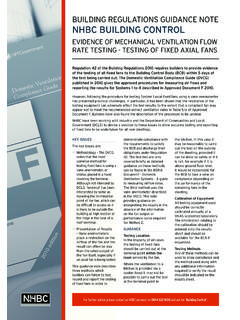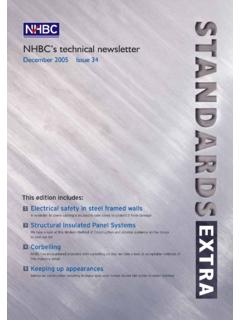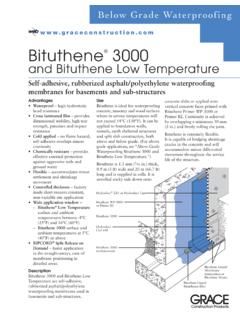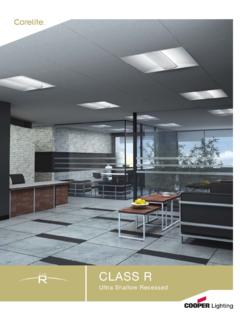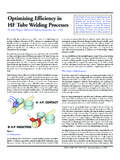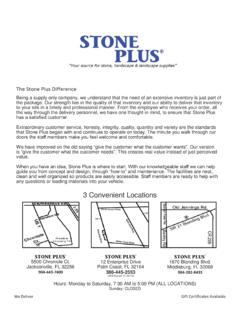Transcription of TG 6.1-28 vertical movement joints - end walls, corners ...
1 CURTAIN WALLING FORMED FROMSTACKED WINDOW ARRANGEMENTS page 1 of 5 MARKING OF SAFETY GLASS 2015 TECHNICAL GUIDANCEMOVEMENT joints IN MASONRY WALLSE - January 2016 (First Issue as Technical Guidance)QUESTIONCONSIDERATIONSM ovement in masonry cavity walls can be caused by a combination of actions including expansion, contraction and the volume changes resulting from the e ects of moisture within the masonry can be reversible such as that caused by temperature variations, or one way as caused by the expansion that occurs as clay bricks age or by shrinkage that occurs as concrete blocks/bricks age. Colour, texture and the orientation of a wall to the sun can also a ect the heat absorbed by the masonry and the resulting degree of size and shape of the masonry panels, whether they are square or long rectangles, as well as the distribution of openings and restraints will also in uence the build up of stresses and subsequent joints should be provided to control expansion and contraction and avoid unsightly cracking.
2 The joints should be properly constructed to cater for the calculated degree of movement without reducing the stability and weathertightness of the wall. ANSWER In cavity masonry walls where should vertical movement joints be located with respect to end walls , corners and window/door openings?Calculating the theoretical movement of a wall is complex which is why general guidance for spacing ofmovement joints is usually adopted. NHBC Standards clause Table 1 quotes joint widths and spacing for movement joints in the outer leaf to minimise the risk of major cracking in di erent types of masonry. The distances quoted, between vertical movement joints , are based on straight sections of expansion of the continuous panels of a masonry box will try to push the corners outwards (see Diagram 1). Where the length of wall exceeds the stated joint spacings, this e ect can be reduced by sub-dividing the wall into shorter lengths of less than the normal spacing (see diagram 2), or by locating the rst movement joint approximately half the stated joint spacing from the corner (see Diagram 3).
3 In theory, an expansion joint could be located at the corner, but this would a ect the buttressing o ered by the return wall unless the masonry was suitably tied in accordance with an engineer s design. In order for a return wall to provide su cient buttressing to the ank wall, without providing additional ties, the expansion joint should be located at least 550mm from the internal corner (see Diagram 3).NHBC NHBC House, Davy Avenue, Knowlhill, Milton Keynes, Bucks MK5 8 FPTel: 0344 633 1000 Fax: 01908 747 255 1/ 2 page 2 of 5 2014 Some guidance suggests that the distance between movement joints , measured around a corner, should be the same as the distance between movement joints in a straight wall. This approach couldlead to a requirement for movement joints in end walls particularly with concrete block/brick practice, providing that the length of an end wall between returns is not greater than the normal spacing of movement joints for the masonry material, it should perform satisfactorily even when the rst movement joint on the return wall is up to half the maximum distance for the masonry clay brickwork walls containing short staggers with o sets less than 675mm, (see Diagram 4), should be treated as if they were a straight wall when determining movement joint spacings.
4 Therefore if the sum of the lengths of wall on either side of the stagger exceeds the maximum length without a movement joint then a movement joint should be introduced into one of the two lengths or at the stagger as shown in Diagram 4. Staggers and movement joints in masonry walls , other than clay brickwork, should be engineer joints should not coincide with door or window openings due to the di culty in continuing the movement joint between the frames and masonry and around the ends of the lintels (see Diagram 6). vertical movement joints should therefore be located in sections of full height masonry between the openings (see Diagram 5). Where a full height masonry panel does not exist (see Diagram 7) the location and detailing of the movement joint should be designed by an engineer to avoid it passing around window and door and door openings in e ect divide the wall into a series of masonry panels.
5 This can lead to uncontrolled cracking in narrow horizontal panels between openings on di erent oor levels. Where the length to height ratio of each panel is high more than 3:1, the distance between movement joints may need to be reduced. Alternatively, bed joint reinforcement may be used to control the stresses. Any reinforcement should be used in accordance with the manufacturer s recommendations. See also Technical Guidance movement joints in clay brick masonry and Technical Guidance Masonry bed joint reinforcement .As a general rule movement joints in the outer leaf of external walls should be provided at not more than the following centres:Clay brickwork - 12m (15m max)Lightweight concrete block/brick (autoclaved or using lightweight aggregates gross density not exceeding 1,500kg/m3) - 6mDense concrete block and brick (using dense aggregate gross density exceeding 1,500kg/m3) - silicate brick - masonry in a parapet wall (length to height ratio > 3.)
6 1) - half the above spacings and from joint widths for clay bricks should be not less than 12m = 16mm and for other masonry not less than 10mm NHBC NHBC House, Davy Avenue, Knowlhill, Milton Keynes, Bucks MK5 8 FPTel: 0344 633 1000 Fax: 01908 747 255 - January 20166. 1/ 2 page 3 of 5 20143= Thermal movement forces. movement is directly proportional to the length of wallWORSTCASE cracking*BESTMJMJMJMJG eneral Note: movement joints in internal walls are not normally necessary for single dwellings unless thewalls are straight and unbroken and over 6m long, in which case the block manufacturer s recommendations should be adopted. This may include the use of bed joint reinforcement in the courses above and below window leaf(brick orblockwork) - wall in excess of maximum length recommended without a movementjoint.
7 corners pushed outwards causingvertical cracking of masonry at 550mmBETTERM ovement joint in centre of wall- Wall ties within 225mm of movement joint @ maximum 300mm centres Up to halfrecommendedlength of wallwithout amovement jointInternal leaf (blockwork)Diagram 1- wall divided into equal sections, each less than maximum recommended length without a movement joint .*-central section of wall between MJ s lessthan the maximum recommended lengthwithout a movement joints provided closer to cornersNHBC NHBC House, Davy Avenue, Knowlhill, Milton Keynes, Bucks MK5 8 FPTel: 0344 633 1000 Fax: 01908 747 255 2 Diagram 3 TECHNICAL - January 20166. 1/ 2page 4 of 5 2014 External leaf(brickwork)Internal leaf(blockwork)= movement forces. movement is directly proportional to the length of wallDiagram 4 - Short staggers in external cavity walls made from clay brickwork.
8 Tendency to crack in these positions< 675mmCompressible joint Slide by jointWORST CASEBETTERA rrangementBESTA rrangement< 675mm< 675mmNHBC NHBC House, Davy Avenue, Knowlhill, Milton Keynes, Bucks MK5 8 FPTel: 0344 633 1000 Fax: 01908 747 255 - January 20166. 1/ 2 page 5 of 5 2014 MJDiagram 5 - movement joint should be in full height masonry between window and door Consideration should be given to the provision of bed joint reinforcement to control movement in the outer leaf where length to height ratio is high greater than 3:1. Similar bed joint reinforcement is often recommended by the block manufacturer within the inner leaf both above and below openings. NHBC NHBC House, Davy Avenue, Knowlhill, Milton Keynes, Bucks MK5 8 FPTel: 0344 633 1000 Fax: 01908 747 255 6 - movement joint should not pass through openings due to the di culty in continuing the joint between the frames and masonry and around the ends of the 7 - Where there is no full height path withinthe masonry the movement joint should be engineer designed to avoid any dooror window openings.
9 The design may involve the introduction of a slip planeto link the staggered - January 2016

